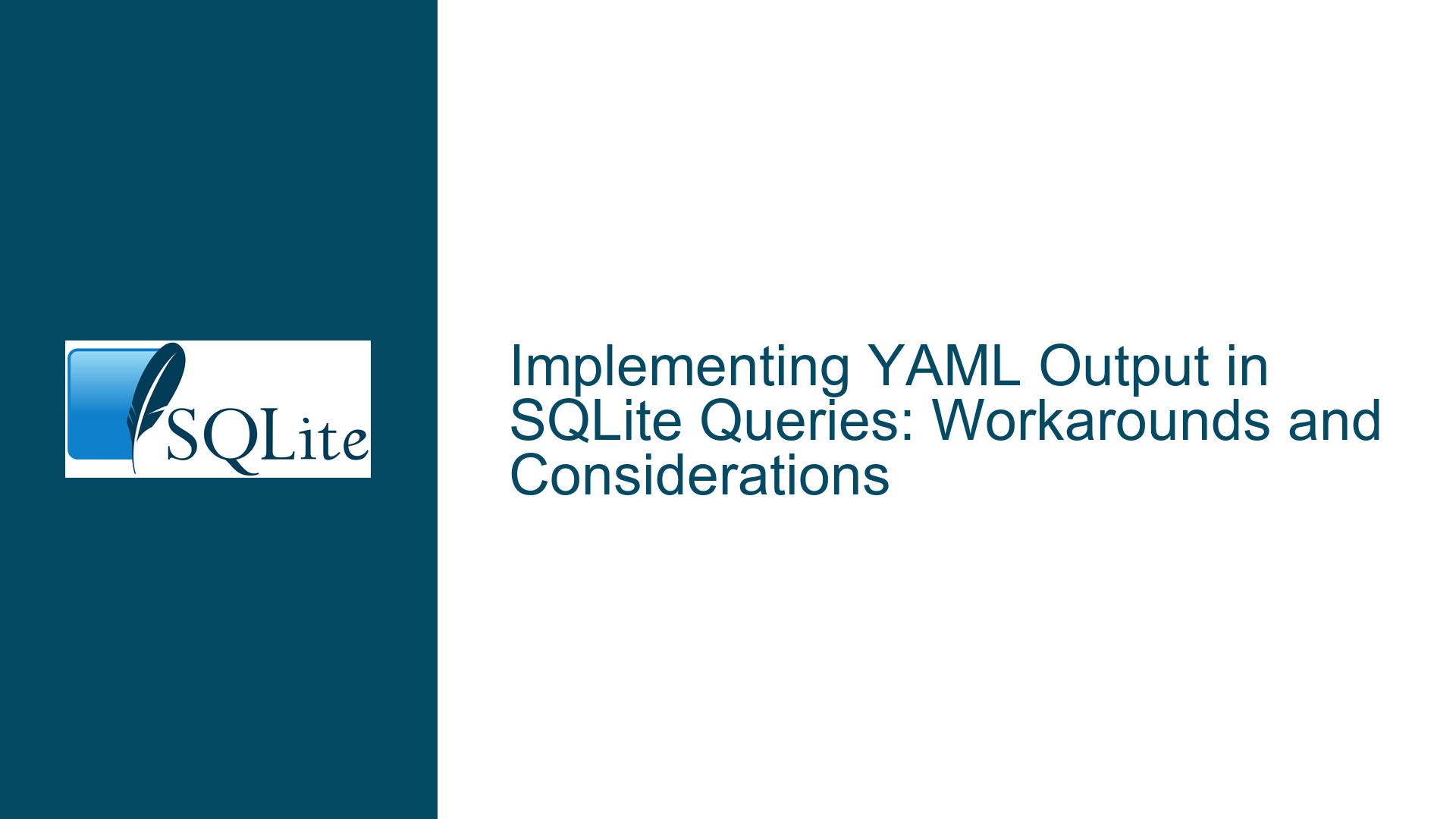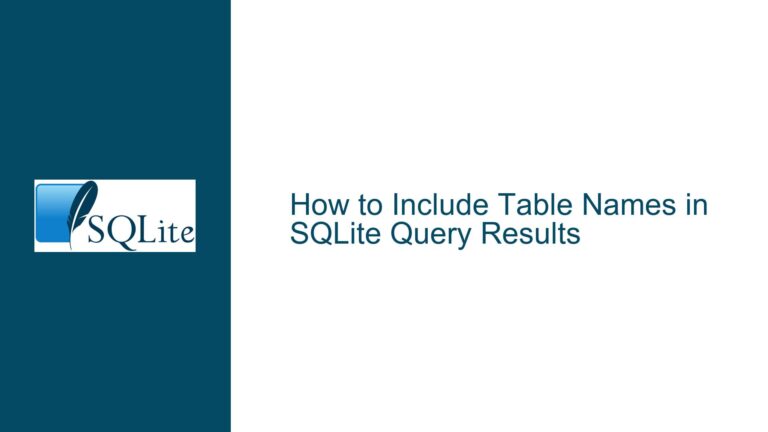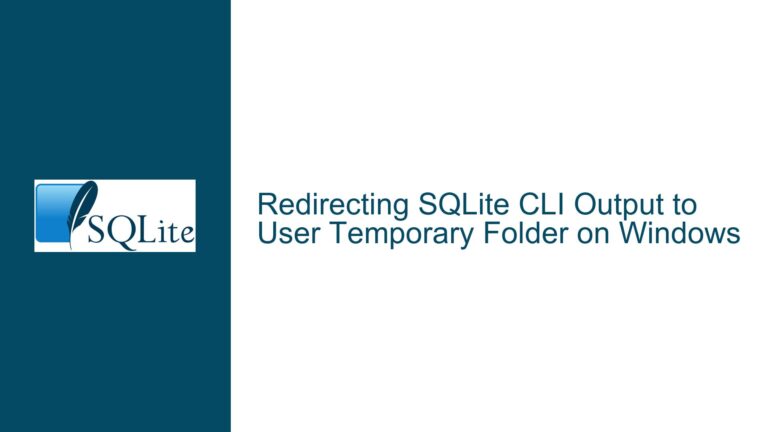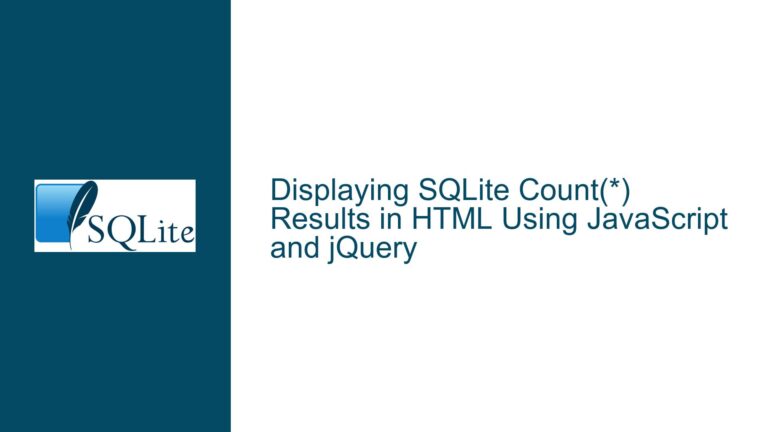Implementing YAML Output in SQLite Queries: Workarounds and Considerations
Understanding the Demand for YAML Output in SQLite and Current Limitations
The SQLite command-line interface (CLI) provides multiple output modes, such as CSV, JSON, and table formats, enabling users to export query results in structured formats. A recurring request among developers working in DevOps or configuration-heavy environments is the addition of a native YAML output mode. YAML’s human-readable syntax and support for complex data structures make it a preferred format for configuration files, Kubernetes manifests, and infrastructure-as-code (IaC) workflows. However, SQLite does not natively support YAML output, leading users to seek alternative methods to bridge this gap.
The core issue revolves around converting SQLite query results into YAML-formatted text. Users often propose that SQLite should include a .yaml mode akin to its .json mode, which directly outputs query results as JSON. Proponents argue that YAML’s features—such as anchors, aliases, and multi-document support—could enhance data portability in scenarios where JSON’s strict syntax or lack of comments becomes a limitation. For example, a user might want to export a list of database records as a YAML array or generate separate YAML documents for each row to integrate with templating systems like Helm or Ansible.
Critics counter that JSON is a subset of YAML 1.2, meaning valid JSON files are inherently valid YAML. This overlap suggests that existing JSON output could suffice for many use cases, with post-processing tools handling the conversion to YAML. Additionally, implementing a native YAML mode in SQLite would introduce maintenance overhead, given YAML’s broader syntax rules and edge cases compared to JSON. The discussion highlights divergent perspectives: one side emphasizes practical usability in DevOps pipelines, while the other prioritizes SQLite’s minimalist design philosophy.
A concrete example from the forum illustrates this tension. A user seeks to transform JSON output from a query like SELECT id, name FROM users into a YAML array:
{"id": "1", "name": "Joe"}
{"id": "2", "name": "Jane"}
{"id": "3", "name": "Jon"}
The desired YAML output is either a single document with a list:
---
- id: 1
name: Joe
- id: 2
name: Jane
- id: 3
name: Jon
Or multiple YAML documents, each representing a row:
---
id: 1
name: Joe
---
id: 2
name: Jane
---
id: 3
name: Jon
While these transformations seem straightforward, SQLite’s lack of native YAML support necessitates external tools or custom scripting. This limitation becomes pronounced in environments where YAML is the de facto standard, and manual conversions are impractical.
Technical and Design Reasons Behind SQLite’s Lack of Native YAML Support
JSON as a Sufficient Subset of YAML
YAML 1.2 specification explicitly declares JSON as a valid subset. Any well-formed JSON document is also a valid YAML document. This relationship allows users to leverage SQLite’s existing JSON output mode, then apply lightweight transformations to align the result with YAML conventions. For instance, replacing curly braces with hyphens or adjusting indentation can convert a JSON array into a YAML list. While this approach does not exploit YAML’s advanced features, it satisfies basic interoperability requirements without requiring changes to SQLite itself.
Complexity of YAML Syntax and Parsing
YAML’s flexibility introduces parsing complexities absent in JSON. Features like custom data types, multi-line strings, anchors, and aliases complicate serialization. For SQLite to natively support YAML, its CLI would need to integrate a YAML library (e.g., libyaml) and handle edge cases such as circular references or type coercion. This would increase the binary size and maintenance burden, conflicting with SQLite’s design goals of simplicity and compactness. In contrast, JSON serialization is simpler: key-value pairs map directly to objects, and arrays correspond to SQL result sets.
Maintenance and Prioritization of Features
SQLite’s development prioritizes stability, performance, and backward compatibility. Introducing a new output mode requires rigorous testing, documentation, and long-term support. The core team evaluates feature requests based on widespread applicability, and YAML’s niche dominance in DevOps—compared to JSON’s ubiquity—may not justify the effort. Community contributions could theoretically add YAML support via extensions, but such implementations would exist outside the canonical SQLite codebase, limiting their visibility and adoption.
Prevalence of External Tooling
The Unix philosophy of composing small, single-purpose tools favors piping SQLite’s JSON output into converters like yq or jq. For example:
sqlite3 -json mydb.db "SELECT * FROM users" | yq -p json
This command converts JSON to YAML using yq, a portable command-line tool. This workflow aligns with SQLite’s modular design, where the CLI focuses on database operations, and formatting is delegated to specialized utilities. Users seeking advanced YAML features (e.g., document separators or custom tags) can process the JSON output with scripts in Python, Ruby, or other languages with robust YAML libraries.
Ambiguity in Use Cases
Advocates for native YAML support often cite specific workflows, such as generating Kubernetes configurations or CI/CD pipelines. However, these cases typically involve post-processing steps where external tools already exist. Without demonstrating unique advantages that necessitate tight integration with SQLite’s CLI, the proposal struggles to gain traction. The forum discussion underscores this: participants acknowledge YAML’s popularity in DevOps but question whether SQLite should expand its scope to accommodate domain-specific formats.
Strategies for Generating YAML Output from SQLite Queries
Leveraging Existing Command-Line Tools
1. Using yq for JSON-to-YAML Conversion
The yq utility (a YAML processor akin to jq) can transform SQLite’s JSON output into YAML. Installation varies by platform:
- macOS:
brew install yq - Linux:
sudo snap install yqor download from GitHub - Windows:
choco install yq
To generate a YAML array from a query:
sqlite3 -json mydb.db "SELECT * FROM users" | yq -p json -o yaml
This produces:
- id: 1
name: Joe
- id: 2
name: Jane
- id: 3
name: Jon
For multiple YAML documents (separated by ---), use yq’s split function:
sqlite3 -json mydb.db "SELECT * FROM users" | yq -p json -o yaml --split-exp '[...][]'
2. Custom Formatting with jq
While jq is primarily a JSON processor, it can structure JSON into YAML-compatible arrays:
sqlite3 -json mydb.db "SELECT * FROM users" | jq -s '.'
The -s (slurp) flag combines input lines into a JSON array, which yq can then convert:
sqlite3 -json mydb.db "SELECT * FROM users" | jq -s '.' | yq -p json -o yaml
3. Handling Complex Data Types
SQLite’s JSON output represents BLOBs as base64 strings. To decode them in YAML, pipe the output through base64 -d:
sqlite3 -json mydb.db "SELECT image_blob FROM products" | yq -p json '.[].image_blob |= @base64d'
Scripting with Python or Ruby
For scenarios requiring custom YAML formatting (e.g., anchors or aliases), scripting offers greater control. A Python script using pyyaml and sqlite3 libraries:
import sqlite3
import yaml
conn = sqlite3.connect('mydb.db')
cursor = conn.cursor()
cursor.execute("SELECT id, name FROM users")
rows = [dict(id=row[0], name=row[1]) for row in cursor.fetchall()]
with open('output.yaml', 'w') as f:
yaml.dump(rows, f, default_flow_style=False)
This generates:
- id: 1
name: Joe
- id: 2
name: Jane
- id: 3
name: Jon
To emit multiple YAML documents:
for row in rows:
yaml.dump([row], f, explicit_start=True, explicit_end=False)
Advocating for Native YAML Support in SQLite
Users passionate about integrating YAML into SQLite can:
- Submit a Formal Feature Request: Detail specific use cases where external tools fall short, emphasizing unique YAML features like document separators or type tags.
- Contribute a Patch: Develop a YAML output module using a library like libyaml, ensuring it adheres to SQLite’s coding standards and testing requirements.
- Leverage SQLite Extensions: Create a loadable extension that adds YAML functions (e.g.,
yaml_group_concat()), though this would require users to install the extension separately.
Performance Considerations
Piping large datasets through external tools may introduce overhead. To mitigate this:
- Use batch processing: Split queries into smaller chunks with
LIMITandOFFSET. - Disable interactive features: Run
sqlite3in non-interactive mode (-batch) to reduce startup latency. - Optimize scripts: Process data in streams rather than loading entire result sets into memory.
By combining SQLite’s JSON capabilities with mature YAML tooling, users can achieve their desired output without waiting for native support. This approach respects SQLite’s design ethos while providing flexibility for DevOps workflows. For those requiring deeper integration, contributing to SQLite’s open-source development or crafting extensions remains a viable path forward.





